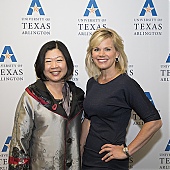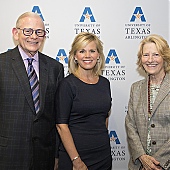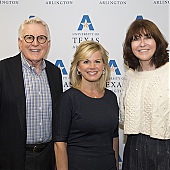Robots to the rescue
These versatile microrobots (and others tinier than a flea) could create a safer America.
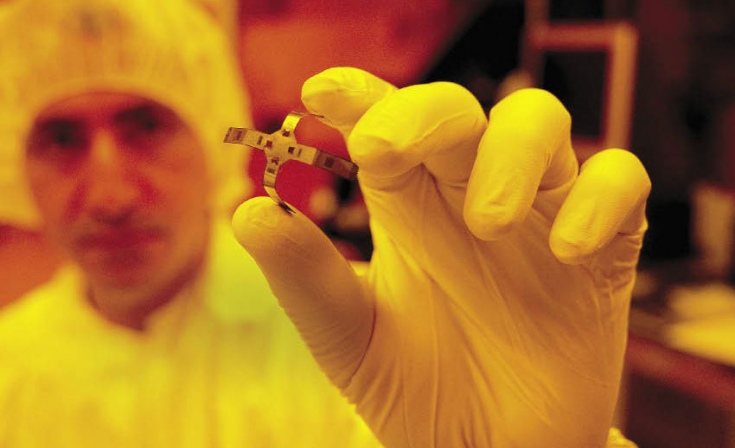
Robotics Revolution
With their surveillance, crowd-control, and intelligence-gathering skills, the tiny robots that UT Arlington researchers are inventing and mass-producing could transform the defense industry.
· Spring 2011 · Comment ·
The slight creature scurrying through the leaves pauses. It darts left to avoid a fallen branch, flattens itself to crawl under yet another branch, them clambers over a pile of refuse before hesitating, as if testing the air. Or scouting an enemy. Or both.
“In my view, we aren’t just one of the front-runners. We are the world university leader in manufacturable microsystems.”
As small as it is—smaller and lighter than a deck of cards with legs—it is transporting even smaller creatures that will soon power up and fan out, testing water and air, listening and watching, perhaps clinging to anything that moves and communicating its location. Maybe they’ll be weapons, going where no person could safely go. They may see in the dark, hear in the silence.
Clearly these are not biological creatures, though they can emulate biological forms by walking and possibly swimming and flying. No, they’re microrobots, essentially sensors of all kinds but with a handy capacity. They can move, take orders, communicate. They can function in harsh environments. Best of all, they’re cheap and expendable, perhaps even self-destructing when their usefulness ends.
And their future is almost now at UT Arlington’s Texas Microfactory, a component of the College of Engineering’s Automation and Robotics Research Institute (ARRI) in Fort Worth. The Texas Microfactory is a global leader in developing microsystems, one component of which is tiny robotic devices that can be mass-manufactured.
Leading the interdisciplinary effort are half a dozen scientists and graduate students who combine forces in robotics, microtechnology, and even chemistry to make what ARRI Director Harry Stephanou calls “flea-sized robots.”
‘FLEA’ MARKET
Dr. Stephanou believes microsystems will be a major U.S. industry, creating tens of thousands of jobs. The Defense Department has invested almost $11 million in microsystems at ARRI, with more likely to come.
“Our defense-oriented work includes research and applications related to swarms of small robots,” Stephanou says. “These can be used for surveillance, for crowd control and dispersal, intelligence gathering, or many other functions.”
Small steps, big impact
Called “Starbot,” this microrobot’s unique leg system allows it to maneuver around obstacles and return to an upright position if it flips over.
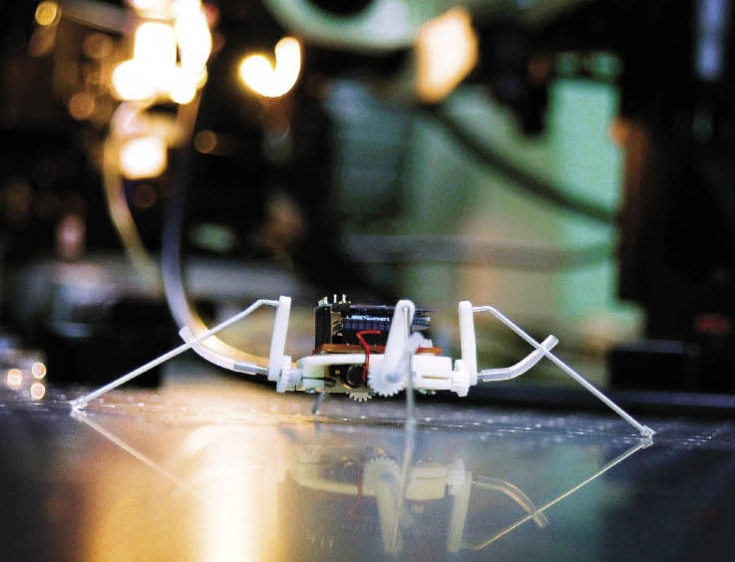
Microrobotics specialist Mohammad Mayyas, a faculty associate researcher at ARRI, says the microfactory has almost perfected the larger devices. “Now we’re working on ways to make tinier and more flexible robots for real-world applications.”
Here’s a quick lesson in microrobotic basics. First, microrobots come with two mechanical styles, discrete and continuous. Discrete models tend to be “bigger”—a few centimeters long—with mechanical parts like legs or wheels, tiny motors, and batteries. Continuous models are usually smaller and manufactured in what appears to be a single piece, though in fact they are composite structures folded into techno-origamis. Their power may come from acoustic or radio waves since they’re too small to carry batteries.
Second, think of microrobots in three sizes. The first are measured in centimeters. The microfactory’s two centimeter models are called “Starbot” and “Casper.” Starbot walks with a unique leg system; Casper essentially rolls. Two microfactory devices in the second group are measured in millimeters and are made through molding, stamping, folding, and assembling. They look somewhat insect-like, which is why they’re named “ARRIpede” and “Flea.” The smallest devices are measured in micrometers—a human hair is about 150 micrometers—and the microfactory’s two models have been labeled “µTags” and “Vibrobot.”
“We think we’re less than a year away from having manufacturable models of the centimeter size, two years or fewer from the millimeter size, and perhaps five years from the micrometer models,” Stephanou says. “But extra funding could speed up that process.”
For Stephanou and the microfactory team, manufacturable is a key word.
“So often there’s a disconnect between academic research and the realities of manufacturing. Just because you can make something in a lab that works doesn’t mean you can quickly and cheaply turn out 100 or 500 or 1,000 or more units. Our emphasis isn’t just on researching microrobotics. We focus on how to make them and many other microsystems a viable industry.”
BEYOND PROTOTYPES
Stephanou’s technological Holy Grail is converting ARRI’s specialized niche into a real-world economic development driver for Texas and the nation.
“We want to create jobs,” he says. “The way to create jobs is to build the economy of the future. The microsystems industry is the way to create tens of thousands of jobs. Academic research and development is wonderful from a science standpoint, but it doesn’t tell us what industry needs in the way of microrobotics.”
What’s needed, he says, is “very clear.”
Assembly required
Researchers in the Texas Microfactory manufacture tiny robots in large numbers.
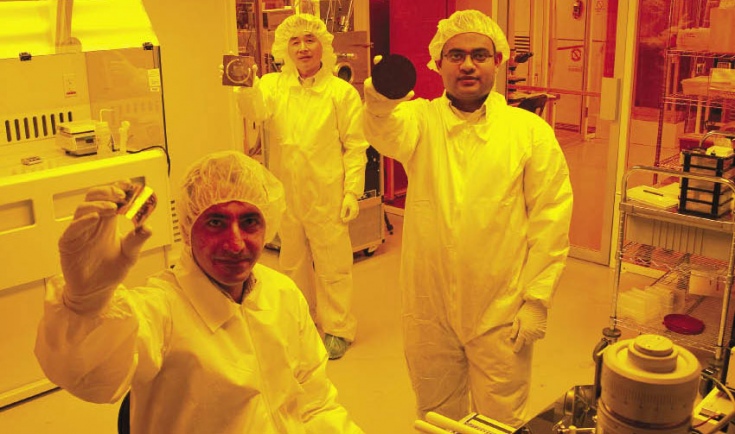
“They need to move from chips to working devices and from there to collections of devices, or systems. That first jump typically accounts for 85 percent of the cost of the devices.”
In short, say ARRI team members Woo Ho Lee and Rakesh Murthy, industry wants actual manufacturing processes—the ability to make the tiny robots on a kind of assembly line.
“Our goal is not only to create products but also the technology to create the products,” Dr. Murthy says. “It’s what’s called concurrent engineering.”
Harry Stephanou, Director, UT Arlington Automation and Robotics Research Institute

The laboratories at the Texas Microfactory are doing just that, producing micromachining modules operating in clean rooms that can turn out the little robots in big numbers. And sometimes very economically.
“Sometimes the tools and devices needed to do this don’t exist in the marketplace,” Murthy says. “So we have to either make them or modify existing products.”
The idea is to create micromachining modules that become assembly lines utilizing as many existing components as possible. This ability to create commercially viable manufacturing systems is a critical distinction for ARRI and the microfactory.
“We differentiate ourselves because we have a chain from innovation to research and development, prototyping, and pilot production,” Stephanou says. “There’s no other university that I have ever seen—even in Germany where they’re good at this sort of thing—that includes pilot production.”
For example, a company might have developed a prototype in the lab and now wants to make batches of 100, or 1,000, or 10,000.
Pilot production
This magnified look at the micromachining technology being perfected by UT Arlington engineers illustrates the ability to create microrobots the size of a flea and smaller.
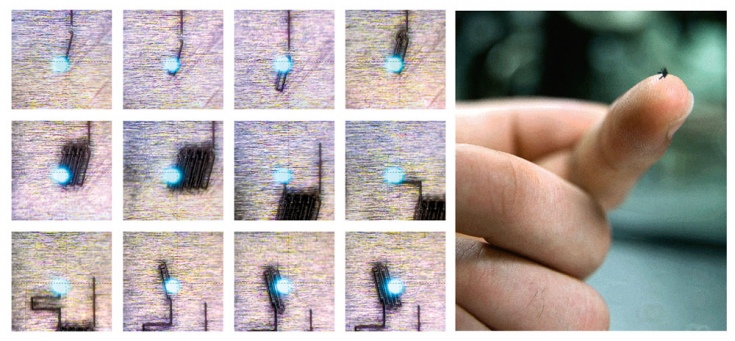
“They look around and say, ‘Where do we buy the equipment for the actual manufacturing?’ ” Stephanou says. “For this kind of technology, the answer often is that the equipment does not exist. And they don’t have a process to make it exist. We do. That’s the value in what we’re doing. We can make such projects viable.”
Microfactory engineers are building machines—manufacturing modules—that can create microrobots at the nano, micron, and millimeter levels.
“The micron level seems to be the sweet spot with the greatest demand right now,” Stephanou says. “Our specialty is that we can produce small runs of devices or products for private companies or government.”
If a company wants to develop 500 units—or 2,000—the microfactory can develop the process and produce the device, such as tiny robots that can carry all kinds of payloads.
When thinking about microsystems, Stephanou believes that it’s critical to remain “technologically agnostic.”
“All too often, scientists or researchers become fixated on one technology or material or another,” he says. “We try to go with what works. If that means using silicon or glass or polymers or metals—molding, stamping, and folding—that’s what we’ll do. There’s no one-technology-fits-all when it comes to making tiny robots or other microsystems.”
He believes UT Arlington is setting the pace.
“We’re only just now scratching the surface of what has enormous economic potential. In my view, we aren’t just one of the front-runners. We are the world university leader in manufacturable microsystems.”
















